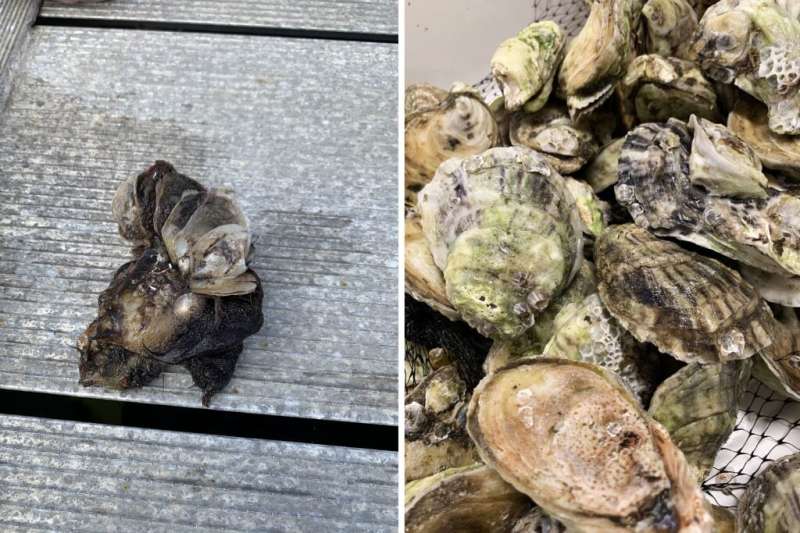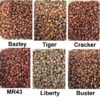Some say the world is your oyster, but the world—especially human impacts on the environment—can actually be found inside an oyster, according to a new study.
When FIU Institute of Environment scientists sampled 156 oysters from Biscayne Bay, Marco Island and Tampa Bay, they detected contaminants—perfluoroalkyl and polyfluoroalkyl (PFAS) and phthalate esters (PAEs)—in every single one. These contaminants pose serious health risks to people and wildlife, and the oysters prove they are in the water and have crept into the food chain. The findings were recently published in Science of the Total Environment.
“I wanted to look into what we’re eating and if it might be contaminating us,” said Leila Lemos, the study’s lead author and an FIU distinguished postdoctoral scholar. “These findings are definitely a red flag, especially for areas like Biscayne Bay.”
As filter-feeders, oysters are among the best sentinels and can reveal a lot about the overall health of an ecosystem, including levels of contamination.
Biscayne Bay oysters had the highest concentrations of contaminants compared to the other study sites. Lemos says this was somewhat surprising since they were among the smallest oysters sampled. The more time an oyster has to grow, the more time it also has to accumulate toxic chemicals. Tampa Bay oysters were among the largest in the study, but they didn’t have nearly the amount of PFAS or PAEs as the tinier Biscayne Bay oysters. This means Biscayne Bay could be so contaminated that the oysters are bombarded with high enough concentrations that they accumulate contaminants faster, Lemos said.
The contaminants are likely interfering with the oysters’ growth, she said, making their small size another clue. In fact, there was a strong correlation between the amount of PFAS in the water and an oyster’s shell thickness and weight. The oysters with the highest concentrations of contaminants had the thinnest shells. The number of contaminants in the area could impair their development—which raises concerns for how chemical contaminants could threaten oyster farming in other parts of the country.

L-R: Biscayne Bay oyster compared to the oysters sampled from Tampa Bay. © FIU
The study also assessed the human health risk of consuming oysters. In this study, the Tampa Bay oysters originated from an oyster farm, so Lemos examined those samples. The good news is that the health risk is low. However, Lemos points out that current assessments only include four PFAS and four PAEs compounds, and don’t look at the majority of compounds. The assessment also does not look at the risks of consuming other marine life that may live in the same waters as the oysters with high contamination.
“It’s important to also remember that there’s so many other exposure paths for both PFAS and PAEs compounds, like drinking water,” Lemos said.
In fact, a previous FIU study, led by FIU chemistry Assistant Professor Natalia Quinete, found around 30 different PFAS in Miami, Broward and Palm Beach tap water, as well as in Biscayne Bay and nearby tributary canals.
PAEs are widely used in consumer products, including pharmaceuticals, cosmetics, personal care products, food packing, detergents, children’s toys and more. Exposure can happen from ingestion, inhalation, and through contact with dirt or soil, and studies have found association between PAE exposure and diabetes, obesity, allergies and asthma, as well as impacts to reproductive health, immune function and more.
PFAS include thousands of man-made chemicals, primarily used in industrial and consumer products. They are found in almost everything including fast food packaging, non-stick cookware, waterproof makeup, clothing, adhesives, firefighting foams and more. PFAS are problematic because they accumulate over time in the water, air, soil—and have even been found in human blood. These chemicals are known to impact reproduction, human development and immune system functioning, and interfere with the effectiveness of vaccines, as well as cause liver and kidney damage.
In June 2022, the Environmental Protect Agency (EPA) warned that PFAS are more dangerous than previously thought, even at undetectable levels. To date, PFAS have not been widely studied in Florida. New data will help inform possible solutions and new regulations to start to remove them from the environment
“The biggest dream is that the government can see these results and create new ways to clean our water and protect our environment,” Lemos said.
More information:
Leila Lemos et al, American oysters as bioindicators of emerging organic contaminants in Florida, United States, Science of The Total Environment (2022). DOI: 10.1016/j.scitotenv.2022.155316
Provided by
Florida International University
Citation:
Florida oysters found to have toxic ‘forever chemicals’ (2022, July 6)


